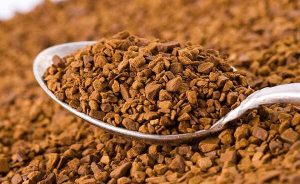
1. Freeze-Dried Coffee?
Freeze-dried coffee is a premium instant coffee, produced using advanced freeze-drying technology. Unlike conventional instant coffee that uses spray-drying at high temperatures, undergoes a deep-freezing process at sub-zero temperatures (usually from -40°C to -50°C) to freeze, after which water is removed by sublimation in a vacuum environment. This process helps to retain the maximum aroma, taste, and natural compounds of pure coffee.

2. How Freeze-Dried Coffee is Made
The production process of freeze-dried coffee typically includes the following main steps:
- Roasting and grinding coffee: High-quality coffee beans are roasted to the appropriate level and ground into powder.
- Extraction: The coffee powder is extracted with hot water to create a concentrated coffee solution.
- Concentration: The coffee solution is concentrated to increase the content of soluble solids.
- Freezing: The concentrated coffee solution is quickly frozen at very low temperatures, forming blocks of coffee ice.
- Grinding: The coffee ice blocks are ground into small granules.
- Freeze-drying (Sublimation): The frozen coffee granules are placed in a vacuum chamber. Here, under low pressure, the ice sublimates directly into vapor without going through the liquid phase, helping to remove water gently.
3. Composition of Freeze-Dried Coffee
Due to the advanced production technology, freeze-dried coffee often retains a composition relatively close to that of roasted and ground coffee, including:
- Caffeine: The caffeine content depends on the type of coffee (Arabica or Robusta) and usually ranges from 1% to over 2.5%. For example, freeze-dried Robusta coffee may have a higher caffeine content than Arabica.
- Antioxidants: Compounds such as chlorogenic acids are preserved, providing antioxidant benefits.
- Flavor and Aroma: The freeze-drying process helps retain the compounds that create the characteristic aroma of coffee, offering an experience close to that of filter-brewed coffee.
- Moisture Content: The moisture content in freeze-dried coffees is usually very low, below 5%, which helps the product last longer.
Some freeze-dried coffees products also clearly state the caffeine content and other quality indicators on the packaging.
4. Export Market of Vietnamese Freeze-Dried Coffee
The global freeze-dried coffees market is experiencing strong growth due to its convenience and quality. Vietnam, with its abundant and high-quality Robusta coffee supply, has significant potential to develop its freeze-dried coffees export market.
Currently, some Vietnamese enterprises have begun investing in freeze-drying technology and introducing freeze-dried coffees products to the international market. Potential markets for Vietnamese freeze-dried coffees include developed countries with fast-paced lifestyles and a preference for convenience, as well as emerging markets with a demand for high-quality instant coffee.
Major Vietnamese coffee exporting companies are also gradually focusing on deeply processed products, to increase export value. Although the current export volume may not be large compared to green coffee beans, with its superior quality and convenience, this promises to be a segment with great potential for Vietnam’s coffee industry in the international market.
In summary, only a convenient product but also the crystallization of modern technology and traditional coffee flavor, opening up many development opportunities for the country’s coffee industry in the global market.
Other articles:
Other agricultural products:


